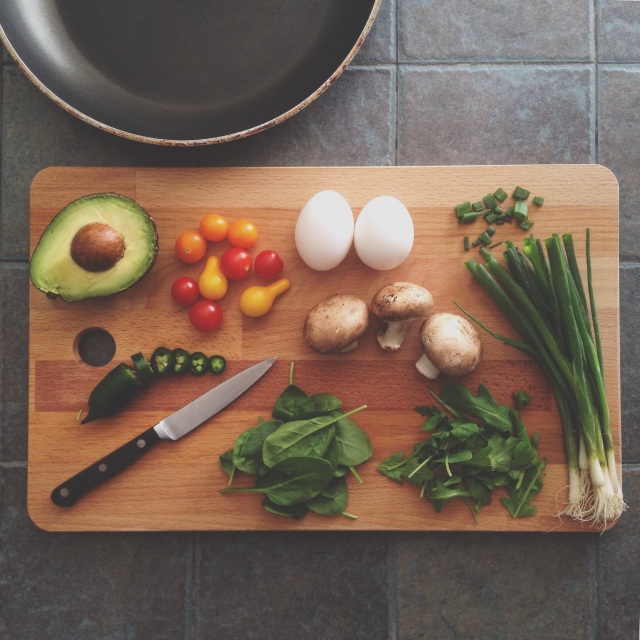I’ve loved cooking since I was a girl. I had a little wooden kitchen set outside where I used to stir up some fantastic mud soups with grass garnishes.
As I got older, I graduated to cooking real food, and when I was a teenager, I got sick of making myself boxed macaroni and cheese, so I taught myself how to cook actual meals. I started off with the classics—comfort foods like pot roast and meatloaf—but now I live a life where animal-based dishes no longer have so much of a place.
When I first started experimenting with cooking vegetables, I had no idea what I was doing, so I pretty much steamed everything and assumed I just didn’t like vegetables.
I hear the same thing from other people fairly often. They say that healthy foods don’t taste good, or vegetarian cooking is bland and unappealing.
This couldn’t be farther from the truth.
Making vegetables (or any food) taste good is all about the preparation. With these simple, totally do-able tips and techniques, anyone can make delicious (vegetarian) dishes in no time:
1. Chop Consistently.
Cut vegetables so that they are similar sizes. This way they will cook evenly. I also try to make everything bite sized or smaller for better “mouth feel.”
2. Don’t Burn the Garlic.
Instant meal destroyer right here. Garlic must be treated gently. Loads of raw garlic or large chunks of garlic in anything will overpower all other flavors until you may as well just be eating a bulb of garlic. When sautéing garlic, add it in as late as possible, make sure there’s enough oil or liquid in the pan, stir constantly, and turn the heat down. Garlic burns in a second, and the taste is horrific.
3. Know your Oils.
Olive oil works well for Mediterranean and Latin American cooking. It cannot be used for frying at high temperatures. Coconut oil or peanut oil is good for Asian dishes and stir-frying, but coconut oil has a strong flavor, so use with caution. I personally think it’s disgusting in egg dishes. My favorite flavorless vegetable oil suitable for frying at high temps is sunflower. Butter makes just about everything taste better, but I never sauté or fry with it because it burns. Instead, I use butter at the end, like a seasoning or a condiment. For vegans, the best butter substitute is easily Earth Balance Organic. Trust me, I have sampled them all.
4. Follow the Recipe (at least at first).
This means no substitutions, no improvisation (cooking is not a comedy show), and no going rogue on the recipe. Make the recipe as written, then next time, after you know what to expect and how the dish is supposed to taste, try some variations. If you don’t believe me, read the comments section of any online recipe and you will find comments like “This recipe was terrible. I don’t recommend it at all—I subbed vinegar for the wine, Crisco for the butter, asparagus for the shallots and I used rice instead pasta. Oh, and I decided to add some French fries and ramen noodles just for fun.”
5. Worship the Holy Trinity.
Everything tastes good sautéed in olive oil, fresh garlic, and crushed red pepper flakes. Everything. Season with salt and maybe a squeeze of lemon at the end. I can eat nearly an entire head of broccoli cooked this way. It’s that good. For an Asian twist, substitute peanut oil and use Tamari, ginger, crushed pepper flakes, scallions and sesame oil.
6. Have Fun with Spices.
Be adventurous with new flavors. Experiment with spice blends from other cultures. Try different curries and unfamiliar sauces.
7. Tomato Paste is your Friend.
Get the kind that comes in a tube like toothpaste and squirt it into soups, beans, and most sauces to-taste. It adds a lot of depth, richness and complexity to meatless dishes.
8. Use Broth.
First find a good veggie broth. Everyone I know prefers a different brand, and they’re all unique, so try a few and decide for yourself. Then keep several boxes in your pantry. I use veggie broth for cooking beans and rice, boiling potatoes and pasta, steaming veggies and in place of water in most recipes (not for baked goods, obviously). It’s also great to have around if you want to throw together a quick pot of soup.
9. Brown is Yummy.
Brown rice, brown bread, toasted anything, caramelized anything—it all tastes better. Just remember, there’s a fine line between brown and delicious, and burnt beyond recognition. I have accidentally crossed this line a few times, but let your foods get crispy, cook onions low and slow until they turn dark and jammy. Broil, roast, let melted cheese form a nice, brown crust. Toast your nuts before adding them to a recipe. Scrape the brown bits from the bottom of the pan and learn to deglaze (here’s a link that tells you how). All of these things will bring out so much more flavor.
10. Cook in Cast-Iron.
I am obsessed with my cast-iron frying pans. I use them for everything. Cast-iron lasts forever and is naturally non-stick without toxic chemicals. In fact, it’s healthier for vegetarians to cook in cast-iron pans, because some of the iron leaches into the food, so the pan actually becomes a valuable mineral source. Besides that, food cooked in cast-iron tastes better because heat is distributed more evenly and the pans absorb oil over time. Get a cast-iron skillet, learn how to season it properly (here is a link), and then use it as much as possible.
11. Avoid the Microwave.
It’s best for reheating and terrible for cooking. Microwaves heat unevenly, make food soggy and rubbery, and do nothing for flavor. I don’t even like baked potatoes from the micro.
12. Roast, Grill, and Sautée.
These techniques impart the most concentrated flavor into foods. Steaming and boiling tend to produce blander dishes, not to mention soggier.
13. Turn Down the Stove Heat.
Most people seem to think their stove burner has only one setting: High. I’ve seen so many recipes ruined just because someone should’ve turned down the heat—especially when frying. Unless you want to sear something on the outside and keep it raw on the inside, the pan doesn’t need to be screaming hot throughout the cooking process.
14. Buy Produce in Season and Avoid Canned and Frozen Foods when Possible.
I know everyone says this, but it’s simple logic: fresh food tastes better. Stuff in cans is generally horrible. Frozen vegetables are the lesser of the evils for sure, but a lot of times I find them to be too soggy. The only exception is that I always buy frozen petite peas, because they are picked and immediately frozen before their sugars convert to tasteless starch.
15. Keep these Flavorful Items on Hand:
Vegetarian chicken-flavored base (I like Better Than Bouillon), boxed veggie broth, tube tomato paste, dark brown sugar, curry powder, scallions, sweet onions, fresh garlic, canned chipotle peppers in adobo, Thai curry paste (whichever color you like best), canned coconut milk, ginger root, sesame oil, balsamic vinegar, raw honey, ground cumin, ground cinnamon, fresh basil (not just for Italian, try it in Asian dishes too!), cilantro (only if you like it), lemon pepper, Sriracha, lemons, crushed red pepper flakes, sea salt.
Start experimenting, and good luck! Have fun with your cooking and make every meal a culinary adventure, and you’ll never think of healthy food as tasteless again.
~
Author: Victoria Fedden
Image: Katie Smith/Unsplash
Editor: Toby Israel
~









Read 0 comments and reply